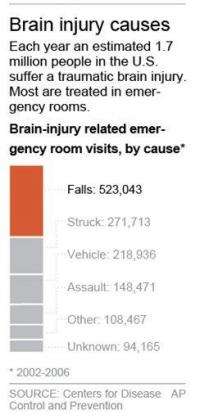Study: Old flu drug speeds brain injury recovery

Researchers are reporting the first treatment to speed recovery from severe brain injuries caused by falls and car crashes: a cheap flu medicine whose side benefits were discovered by accident decades ago.
Severely injured patients who were given amantadine got better faster than those who received a dummy medicine. After four weeks, more people in the flu drug group could give reliable yes-and-no answers, follow commands or use a spoon or hairbrush - things that few of them could do at the start. Far fewer patients who got amantadine remained in a vegetative state, 17 percent versus 32 percent.
"This drug moved the needle in terms of speeding patient recovery, and that's not been shown before," said neuropsychologist Joseph Giacino of Boston's Spaulding Rehabilitation Hospital, co-leader of the study. He added: "It really does provide hope for a population that is viewed in many places as hopeless."
Many doctors began using amantadine for brain injuries years ago, but until now there's never been a big study to show that it works. The results of the federally funded study appear in Thursday's New England Journal of Medicine.
A neurologist who wasn't involved in the research called it an important step. But many questions remain, including whether people less severely injured would benefit, and whether amantadine actually improves patients' long-term outcome or just speeds up their recovery.
Each year, an estimated 1.7 million Americans suffer a traumatic brain injury. Falls, car crashes, colliding with or getting hit by an object, and assaults are the leading causes. About three-quarters are concussions or other mild forms that heal over time. But about 52,000 people with brain injuries die each year and 275,000 are hospitalized, many with persistent, debilitating injuries, according to government figures.
With no proven remedies to rely on, doctors have used a variety of medicines approved for other ailments in the hopes that they would help brain injury patients. Those decisions are based on "hunches and logic rather than data," said Dr. John Whyte, of the Moss Rehabilitation Research Institute in suburban Philadelphia. He led the study along with Giacino.
Amantadine (uh-MAN'-tah-deen), an inexpensive generic, was approved for the flu in the mid-1960s. The first inkling that it might have other uses came a few years later when it appeared to improve Parkinson's symptoms in nursing home patients who got it. It was found to have an effect on the brain's dopamine system, whose many functions include movement and alertness, and it was later approved for Parkinson's.
It's now commonly used for brain injuries, and the researchers felt it was important to find out "whether we're treating patients with a useful drug, a harmful drug or a useless drug," Whyte said.
The study was done in the U.S., Denmark and Germany and involved 184 severely disabled patients, about 36 years old on average. About a third were in a vegetative state, meaning unconscious but with periods of wakefulness. The rest were minimally conscious, showing some signs of awareness. They were treated one to four months after getting injured, a period when a lot of patients get better on their own, Giacino noted.
They were randomly assigned to receive amantadine or a dummy drug daily for four weeks. Both groups made small but significant improvement, but the rate of recovery was faster in the group getting amantadine. When treatment stopped, recovery in the drug group slowed. Two weeks later, the level of recovery in the two groups was about the same.
There was no group difference in side effects, which included seizure, insomnia and rigid muscles.
The study was short, and the effect on long-term outcome is unknown. But Giacino said the drug still has value even if it only hastens recovery.
"What condition would we not jump for joy if we could have it over with faster?" he said.
The study didn't include those with penetrating head injuries, like the gunshot wound former Rep. Gabrielle Giffords suffered, but Giacino said the drug should have similar effects in those patients. Whether it would work in patients with brain injuries not caused by trauma, such as a stroke, isn't known.
Whyte said the researchers want to test the drug for longer periods.
Dr. Ramon Diaz-Arrastia said the results were welcome news in a field that has seen many failed efforts. He is director of clinical research at the government's Center for Neuroscience and Regenerative Medicine, which works with the military and government scientists on brain injury research.
"It's an important step toward developing better therapies," he said.
Since amantadine is so commonly used, he said U.S. troops with severe brain injuries in Iraq or Afghanistan probably get it, or should get it now. Since 2000, some 233,000 troops have suffered traumatic brain injuries, including about 6,100 serious cases, many of them from bomb blasts or shrapnel.
Laura Bacon said amantadine seems to be helping her brother recover from a car accident in Vermont last October. Nicholas Gnazzo, 47, of Rochester, N.H., was in a coma for weeks before he was taken for rehabilitation to Spaulding, where doctors put him on amantadine in January.
Since then he has been more alert, able to communicate with nods or gestures - like pointing to his eyes when he wants his glasses, his sister said. Giacino agreed her brother has gotten better, but whether it is because of the drug can't be determined. Gnazzo wasn't part of the study.
"It's been four months now, and we know we still have a long way to go," Bacon said. "Anything that could be faster - or feel faster to us - is a positive."
More information: CDC info: http://www.cdc.gov/traumaticbraininjury/
Military TBI website: http://www.dvbic.org
Journal: http://www.nejm.org
©2012 The Associated Press. All rights reserved. This material may not be published, broadcast, rewritten or redistributed.














